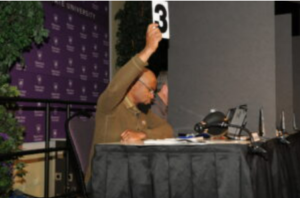Learning from your Audience During & After your Speech
You know that you need to adapt to the audience before you present. What about during and after your delivery?
During the Speech
If an audience is getting bored, restless, confused, or irritated, it’s important for the speaker to recognize and adapt to the situation.

Nonverbal language is a strong clue for the speaker that they have lost a person or the group. If someone starts yawning, rolling their eyes, looking at their phone, or staring into space, most likely you have not connected with them.
Chatter is another strong indicator that the audience is not connecting with you. The audience might start talking very quietly as you are speaking. While this may be rude, it also is incumbent upon you to switch course and try to connect with them.
Of course, falling asleep is an obvious signal that the person is not connecting to what you have to say. No one wants to see someone’s chin drop to their chest during the speech. This sight can be very discouraging to the speaker. However, since falling asleep is involuntary, it often has more to do with the situation of the listener than the content of the speech.
It can be tricky to read a room. Sometimes when people look uninterested or distracted, they’re actually thinking hard. Other times a listener might seem restless and impatient, when in fact they’re excited about the speech. The same can be said of doodling on paper—some listeners focus better when they’re drawing or doodling. If someone is typing on a laptop throughout your talk, are they taking notes on your great ideas? Or catching up on email? Try not to assume the worst, since this will only add to your stress and negatively affect your performance.
Don’t panic—but do adapt. The following strategies to reengage your listeners can be helpful even if the audience is still with you, and even more so if you’ve lost them.
Adapting to your Audience During your Speech
When you see signs that you’re losing the audience’s attention, it is time for to switch gears and adapt to the situation. The technique you use to change the situation is completely dependent upon your assessment of who the audience is. Here are some ideas.
Movement
For long presentations such as a lecture, workshop, or training, it can be very helpful to stop the speech momentarily and ask the audience to stand up and stretch or walk around a bit. People do not have long attention spans and are used to shorter sound bites; so, it is helpful to get their blood flowing and moving. Most of the time, people will be more engaged after they move around.
Examples
Sometimes, the examples you are using do not connect with the audience. How do you know that the examples are working? Look at people’s faces. Do they look puzzled or confused? Do they start to chatter or tune out? If this is the case, be prepared to speak more extemporaneously and think of new examples on the fly.
Audience Input

There are times when a speaker feels like they just can’t connect to the group. When this is the case, try soliciting input from the audience. Ask them a question. Make a statement that requires agreement or disagreement via a show of hands.
Silence
Don’t be afraid to use silence. There are occasions when it works to stop talking. Silence can be your way to let the audience know you get it—they are bored. It allows the group to gather themselves and refocus on your speech. It gives you time to think about how to improve based upon the audience’s boredom.
Shantelle was asked before her first day on the job to prepare a five-minute introduction to give to the company on her first day. On the day of the speech, Shantelle started to give her speech in front of one hundred new colleagues. One minute into the speech, she could see that some were beginning to chatter and others were glancing at their phones. She could have gotten upset and let her emotions get the best of her, but she did not. Shantelle stopped speaking and was silent for a moment to gather her thoughts. She then asked the group a question: “how do you feel about being at work today?” Shantelle then went on to say that she was excited to be here and asked a couple of more questions that people could answer by raising their hands. After the speech, several people introduced themselves and welcomed her to the company. Shantelle had switched gears mid-speech to make her introduction a success.
Adapting your speech as you are presenting requires observing your audience and paying attention to their cues.
In the following video, Obama deals with interruptions by protesters and hecklers. Although negative verbal feedback is less common than negative nonverbal feedback, it can happen, especially if you’re talking about a politically sensitive issue, so it’s something to be aware of and prepared for. Depending on the nature of the interruption, it may be best to ignore it, but it may also be a good idea to acknowledge the disagreement and move forward. Rather than getting upset about the interruptions, Obama uses these moments to make impromptu arguments about civil discourse, political conversation, and the legislative process.
You can view the transcript for “How President Obama handles hecklers” here (opens in new window).
Here is the video with accurate captions: How President Obama Handles Hecklers (opens in new window).
After the Speech
It is very common to forget about your presentation once it’s done. It’s relieving to finish and move on. However, that is not how you can become a better public speaker. To grow and learn and be asked to speak again, you should try to gather feedback using any of the following strategies.
Surveys
Survey the audience, either with an electronic or paper survey. A survey does not have to be elaborate. It could simply be two questions: What was done well? and What can be improved? If you want a more in-depth survey, that’s fine as well.
If you decide to gather feedback through a survey, make sure you read the feedback and incorporate what you learn. Do not make judgements on a response. Instead think about why that response might be there and what kind of change is needed.
Informal Feedback

Your feedback probably won’t be as instant as shown here, but it’s good to solicit feedback shortly after your speech.
Another way that you can learn is to ask someone in the audience how the speech went. Ask that person to be honest with constructive ideas and as specific as possible. This allows you to start a dialogue about your presentation and learn what you really want to keep doing and what you should improve in your next speech. If you can, ask a friend to come with you to a speech and deconstruct the speech experience. That friend can tell you their thoughts on how the audience reacted, whether they felt there was a connection, what might be improved, or what worked really well.
- Solicit feedback in advance. If you let a friend or colleague in the audience know you’d like to ask for their feedback after the performance, they’ll be better able to keep track of concrete details about your performance. They can also be very helpful in offering another perspective on audience reactions.
- Be specific about what kind of feedback you want. Let your friend or colleague know what you’re most interested in working on. For instance, if you’re working on your vocal tone and pace, let your friend or colleague know to focus on that. Perhaps you want to know how your nonverbal language comes across, or maybe there’s a specific part of the talk you’re most interested in getting feedback on. The more this person knows about your main concerns, the better they’ll be able to help you.
- Ask for feedback right away. Details get fuzzy very quickly, so it’s important to solicit feedback as close to the event as possible.
Self-Evaluation
Self-evaluation can be one of the most effective ways to learn from and improve your public speaking performance. To do it well, however, you have to follow a few principles:
- Self-evaluation must be immediate. Don’t wait a few days or weeks after your performance. As soon as you can, spend a few minutes writing down your impressions (a dedicated journal can be a great place to keep track of these thoughts).
- Self-evaluation must be structured and specific. Don’t just stop with “OK, that went well” or “Yow, that was rough.” Instead, ask yourself specific questions like “which parts of the speech seemed to land best with the audience? How do I feel about my nonverbal presentation? How did I do with the time limit?” In the video below, Allison Shapira describes the three questions she uses for self-evaluation: “What did I do well? What didn’t I do so well? What am I going to do differently next time?”
- Self-evaluation must be frequent. It’s hard to track progress when you only have one or two distant data points. Instead, try to begin a practice of regular self-evaluation around your speaking skills. Even after a relatively informal situation like a professor’s office hours, a discussion with co-workers, or a team meeting, jot down some notes about what you did effectively and what you’d like to improve.
Recordings
Most people don’t like to see themselves on camera. However, watching a recording of your speech can be the best way to get a sense of what the audience experiences when you speak. You’ll be able to catch all sorts of details you wouldn’t otherwise notice, from filler words like “um” and “like” to awkward gestures or movements. You’ll also see a lot of the good points of your speaking style, and learn to build on your strengths to become a more effective public communicator.
In this short video, former opera singer and public speaking expert Allison Shapira describes an easy but effective method for improving your public presentation skills through self-evaluation.
You can view the transcript for “How to evaluate your speeches and presentations” here (opens in new window).
Here is the video with accurate captions: How to Evaluate Your Speeches and Presentations (opens in new window).
- Tips adapted from Gonzalez, Meghan. “How to Get Feedback on Speeches (opens in new window).” Global Public Speaking. 24 Mar. 2017 ↵
